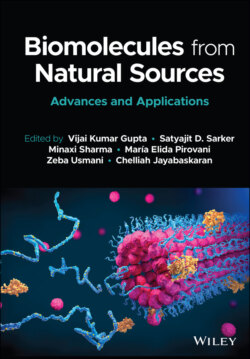Читать книгу Biomolecules from Natural Sources - Группа авторов - Страница 28
1.7 Identification and Characterization
ОглавлениеGlycolipids can be identified and characterized using a broad range of techniques from simple colorimetric assays to sophisticated techniques, like mass spectrometry (MS) and nuclear magnetic resonance (NMR).
The choice of the chemical and structural analysis of glycolipids depend on the purpose. The experimental procedure mainly rely on the following key steps: (i) extraction of glycolipids from the culture medium, (ii) detection; (iii) separation and purification of the crude product (iv) structural analysis.
In the first step colorimetric methods can be used to evaluate the presence of the biosurfactants in either the culture medium or the extract. Detection can be carried out using assays based on the detection of sugar moieties, such as anthrone (Hodge and Hofreiter 1962) or orcinol assay without the need for extraction. The anthrone method is a colorimetric technique based on the reaction of anthrone with the sugar, forming a coloured complex that can be quantified in the visible region, by spectrophotometry. However, interferences from chemicals and carbon sources can result in inaccurate results and, therefore, these methods should only be used as a rough indicator of glycolipid production.
Thin layer chromatography (TLC) is a simple method that allows the detection of glycolipids and can also provide information on possible structural types of glycolipids present in the sample. TLC detection should be carried out before purification procedures to evaluate the presence of glycolipids and should be used afterwards to determine purity.
Further analyses are required for both quantification and/or identification of structural features, mainly using high-performance liquid chromatography-mass spectrometry (HPLC-MS) (Marqués et al. 2009) and nuclear magnetic resonance (NMR) (Kügler et al. 2014). Among these techniques, mass spectrometry offers the greatest amount of information with regard to purity and structural conformation of carbohydrate and fatty acid components of the glycolipids.
In fact, HPLC is a method that allows the separation of glycolipids and when coupled with an evaporative light scattering detector (ELSD) or mass spectrometry provides valuable information related to the identification and quantification of glycolipids. HPLC-UV can also be used for analysis when the test compounds have been derivatized to p-bromophenacyl esters (Mata-Sandoval et al. 1999).
In the specific case of trehalose lipids many techniques can be used for the identification and characterization. Similar to other glycolipids, trehalose lipid content can be estimated using the colorimetric anthrone method. Also TLC has been extensively used in the detection of trehalose lipids. A few solvent systems have been used to separate trehalose lipids, although the most frequently used is chloroform:methanol:water (65:15:2) for the mobile phase (Christova et al. 2015) and to reveal them, using a chemical developer, frequently made of acetic acid: anisaldehyde: sulfuric acid, under 150°C airstream for 2–4 min. Trehalose lipids appear in the form of spots (Kügler et al. 2014), with the monomycolates near the point of application of the sample and the mark of dimycolates a little further away.
High-performance liquid chromatography (HPLC) and reverse phase (HPLC-RC) have been used for the identification of trehalose lipids (Janek et al. 2018), especially with mass spectrometry HPLC (HPLC-MS) it is possible to disclose the glycoside linkage between two of the sugar moieties (Patil and Pratap 2018). Moreover reversed-phase HPLC (HPLC-RC) was also used for the identification of these compounds.
Mass spectrometry (MS) provides detailed structural information on the molecular mass of the compounds under investigation. Tandem MS (MS/MS) results in the fragmentation of structures thus allowing the identification of individual isomers without the need for separation. Moreover, when combined with HPLC, it provides the most sensitive method for identification and quantification of trehalose lipids. A drawback is that it requires a high level of purification as salts and free non-polar lipids can induce suppression of ion signals under MS conditions. Glycolipids can be analyzed on all types of mass spectrometers, with electrospray ionization (ESI-MS) and matrix assisted laser desorption ionization (MALDI) (Yagi-Utsumi 2019).
Electrospray ionization provides excellent trehalose lipid ionization when used for direct infusion or HPLC-MS. Using this technique virtually no fragmentation occurs in the primary molecules under investigation. Ionized molecules are detected by a mass analyzer according to their mass to charge ratio (m/z) and can be fragmented using collision-induced dissociation (CID) to provide valuable information about each structure and their isomers (Yagi-Utsumi 2019).
MALDI is a soft ionization mass spectrometry technique that allows the identification of intact compounds. Basically, samples to be analyzed are mixed with a matrix and dried on a platform, onto which a laser is fired with various degrees of energy, thus forming gaseous ions, which can then be observed in a time of flight analyzer (Yagi-Utsumi 2019).
The characterization can be done by breaking down the structure separating the fatty acids from the carbohydrate or just by analysing the entire molecule. Mass spectrometry or mass spectrometry in conjugation gas chromatography (GS) (Christova et al. 2015) can be used.
To achieve a full structural determination, nuclear magnetic resonance spectroscopy (NMR) is utilized and is the most powerful method able to identify functional groups as well as the position of linkages within the carbohydrate and lipid molecules. Using a series of NMR experiments the exact location of each functional group can be obtained and information about the structural isomers is also possible (Sato et al. 2019).
Fourier-transform infrared spectroscopy (FTIR) is applied for the characterization of trehalose lipids, once these molecules form polymeric aggregates in aqueous media above the critical micellar concentration (CMC). The type of aggregate structure can play a biological role and is determined by the shape of the contributing molecules which is determined by their primary chemical structure and is influenced by pH, concentration of mono- and divalent cations, among others (Brandenburg and Seydel 1988).
